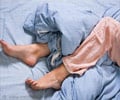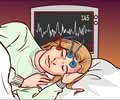Teenagers tend to delay bedtimes during Spring, thanks to the later sunset and extended daylight exposure in the season, say researchers at Rensselaer Polytechnic Institute's Lighting

Over time when coupled with having to rise early for school, this delay in sleep onset may lead to teen sleep deprivation and mood changes, and increase risk of obesity and perhaps under-performance in school, according to Figueiro.
"This is a double-barreled problem for teenagers and their parents. In addition to the exposure to more evening daylight, many teens also contend with not getting enough morning light to stimulate the body's biological system, also delaying teens' bedtimes," said Figueiro.
The new findings detail the impact of early evening light in spring on melatonin onset and sleep times.
The study by Figueiro and LRC Director Dr. Mark Rea, found that 16 eighth-grade students from Algonquin Middle School in upstate New York experienced a delay in melatonin onset by an average of 20 minutes measured in one day in spring relative to one day in winter.
Melatonin levels normally start rising two to three hours prior to a person falling asleep.
The results of the study demonstrated that it was the extended daylight hours due to the seasonal change, not evening electric lighting after dark in the home, that had the biggest impact on delayed sleeping patterns.
"This latest study supplements previous work and supports the general hypothesis that the entire 24-hour pattern of light/dark exposure influences synchronization of the body's circadian clock with the solar day and thus influences teenagers' sleep/wake cycles," explained Figueiro.
"As a general rule, teenagers should increase morning daylight exposure year round and decrease evening daylight exposure in the spring to help ensure they will get sufficient sleep before going to school," he added.
The study has been published in Chronobiology International.
Source-ANI
 MEDINDIA
MEDINDIA



 Email
Email










